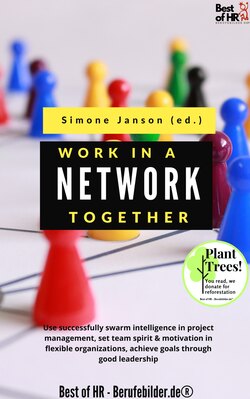Читать книгу Work Together in a Network - Simone Janson - Страница 7
На сайте Литреса книга снята с продажи.
ОглавлениеEmployee motivation for managers: decision-making in the network
// By Michael Hübler
It takes a clear argument about the meaningfulness and folly of hierarchies in each individual company. The goal should be a good balance between hierarchies and networks.
Networks in knowledge management
The concept of the network is used, in particular, in knowledge management when it comes to the fast and smooth exchange of information.
Networks are pragmatic and do not ask for permission. For example, employee A can ask employees B from another department what insights the last project yielded without informing the head of department.
Higher information flow
Networks promote the flow of information. And since information is necessary to drive tasks, this input, which employees get from others, acts as fuel to motivation.
Therefore, one of the most important tasks of leaders is to clarify how information flow can be used as a natural feedback to foster employee motivation.
The following four questions are of particular importance:
Is it known who has what competencies, which knowledge and what information does it have?
Is it known how and when I reach these people best?
Are these people willing to share their knowledge? And is this allowed, even across hierarchies? +
Do employees dare to ask other employees across departmental boundaries? Or do they fear negative consequences, for example, loss of prestige?
Small teams on site
In addition to the exchange of information, the question of decision-making powers also arises. Risky professions, for example in the military or aerospace sectors, need hierarchies to clearly define the responsibilities. In many other branches, the network idea has been going on for several years.
In other words, small teams on the ground are closer to the customer, so they know more and can therefore make better and faster decisions within a certain framework. In addition to the budget, the customer comes more into focus, which accommodates the balanced scorecard idea.
When hops and malt are lost
And each of these employees needs something different to deliver a minimum of performance. Some of you just have to do a little bit, and it's going to happen by itself. Others need an open ear ten times a day and some warm-hearted words and for others, hop and malt is lost. So sorry for you.
But there are such enlightening moments in which we have to admit that dealing with some employees can only be about preventing the worst, and agreeing on a modus Vivendi on an adult basis, especially if dismissal, for whatever reason always - from lacking alternatives to nepotism - is not an option.
Once again compact
It is always important to illuminate the two sides of a coin. On the one hand, it is important for you as a manager to clarify which roles you should take selectively depending on the situation in order to influence your employees.
Even if there are almost hopeless cases, this model should lead to a limited amount of damage. On the other hand, clarity of decision-making structures and hierarchies is also needed. Both together give the employees the necessary orientation during their professional life.
Text comes from: Mitarbeitermotivation: Die neue Lust auf Leistung (2014) by Michael Hübler, published by BusinessVillage Verlag, Reprints by friendly permission of the publisher.
